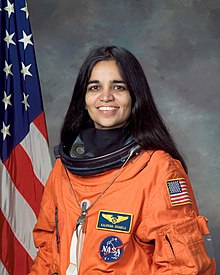Kalpana Chawla
| Kalpana Chawla | |
|---|---|
 | |
| Astronaut | |
| Statsborger | USA, Indien |
| Nationalitet | Amerikaner |
| Født | 1. juli 1961 Haryana Indien |
| Død | 1. februar 2003 (41 år) over Texas |
| Gravsted | Zion National Park, Arlington National Cemetery |
Andet arbejde | Forsker |
| Uddannelses- sted | University of Texas at Arlington Tagore Baal Niketan Sr. Sec. School, Karnal PEC University of Technology University of Colorado Boulder |
Tid i rummet | 31d 14t 54min |
| Udvælgelse | NASA-gruppen fra 1994 |
| Mission(er) | STS-87 • STS-107 |
| Missionsemblemer | |
Kalpana Chawla (født 1. juli 1961, død 1. februar 2003) var en amerikansk / indisk forsker og astronaut og den første astronaut af indisk herkomst[1]. Hendes første rumfærd var ombord rumfærgen Columbia som missions specialist og robot arms operatør.
Hendes anden og sidste rumfærd var den tragiske mission STS-107 (også kaldet Columbia-ulykken), som endte med at rumfærgen Columbia disintegrerede ved genindtrædelsen i jordens atmosfære, hvorved hun og de syv andre astronauter om bord omkom.
Referencer
Eksterne henvisninger
- Biografi Kalpana Chawla NASA (engelsk)
- STS-107 Crew Memorial Arkiveret 4. marts 2016 hos Wayback Machine (engelsk)
|
Medier brugt på denne side
The STS-87 patch is shaped like a space helmet symbolizing the Extravehicular Activity (EVA) on the mission in support of testing of tools for the assembly of the International Space Station (ISS). Earth is shown reflected on the backside of the helmet. The Space Shuttle Columbia forms the interface between the Earth and the heavens, the back and front sides of the helmet in profile. The three red lines emerging from Columbia represent the astronaut symbol as well as the robot arm, which was used to deploy and retrieve the Spartan satellite.
The text 'µg' represents the payloads studying microgravity science in space on this United States Microgravity Payload (USMP-4) mission. Gold flames outlining the helmet visor represent the corona of the Sun, which will be studied by Spartan. The flag of Ukraine is next to the name of the payload specialist who is the first person from that nation to fly on the Space Shuttle.
Kalpana Chawla, American astronaut who died during the failed re-entry of Space Shuttle Columbia.
STS107-S-001 (May 2001) This is the insignia for w:STS-107, which is a multi-discipline microgravity and Earth science research mission with a multitude of international scientific investigations conducted continuously during the planned 16 days on orbit. The central element of the patch is the microgravity symbol, µg, flowing into the rays of the astronaut symbol. The mission inclination is portrayed by the 39 degree angle of the astronaut symbol to the Earth's horizon. The sunrise is representative of the numerous experiments that are the dawn of a new era for continued microgravity research on the International Space Station and beyond. The breadth of science conducted on this mission will have widespread benefits to life on Earth and our continued exploration of space illustrated by the Earth and stars. The constellation Columba (the dove) was chosen to symbolize peace on Earth and the Space Shuttle Columbia. The seven stars also represent the mission crew members and honor the original astronauts who paved the way to make research in space possible. The Israeli flag is adjacent to the name of the payload specialist who is the first person from that country to fly on the Space Shuttle.


